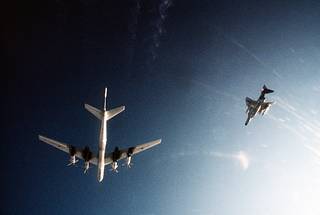
Similar
AN air-to-air underside view of a Soviet Tu-95 Bear aircraft, left, being observed by a U.S. Air Force F-4 Phantom II aircraft over international waters
Summary
The original finding aid described this photograph as:
Country: North Atlantic Ocean
Scene Camera Operator: MSGT Richard Diaz
Release Status: Released to Public
Combined Military Service Digital Photographic Files
Détente (French pronunciation: [detɑ̃t], meaning "relaxation") is the easing of strained relations, especially in a political situation. The term is often used in reference to the general easing of the tensions between the Soviet Union and the United States which began in 1969, as a foreign policy of U.S. presidents Richard Nixon and Gerald Ford called détente; a "thawing out" or "un-freezing" at a period roughly in the middle of the Cold War. Détente was known in Russian as разрядка ("razryadka", loosely meaning "relaxation of tension"). After the Cuban Missile Crisis of 1962, the two superpowers agreed to install a direct hotline between Washington D.C. and Moscow (the so-called red telephone), enabling leaders of both countries to quickly interact with each other in a time of urgency, and reduce the chances that future crises could escalate into an all-out war. The U.S./U.S.S.R. détente was presented as an applied extension of that thinking. The SALT II pact of the late 1970s continued the work of the SALT I talks, ensuring further reduction in arms by the Soviets and by the US. The Helsinki Accords, in which the Soviets promised to grant free elections in Europe, has been called a major concession to ensure peace by the Soviets. The period was characterized by the signing of treaties such as SALT I and the Helsinki Accords. Another treaty, START II, was discussed but never ratified by the United States. There is still ongoing debate amongst historians as to how successful the détente period was in achieving peace. Détente ended after the Soviet intervention in Afghanistan and US boycott of the 1980 Olympics in Moscow. Ronald Reagan's election as president in 1980, based in large part on an anti-détente campaign, marked the close of détente and a return to Cold War tensions. In his first press conference, president Reagan said "Détente's been a one-way street that the Soviet Union has used to pursue its aims.
The Tu-95 BEAR was perhaps the most successful bomber produced by Soviet aviation. It was the only bomber deployed by any country to use turboprop engines, which provided extraordinarily long endurance at speeds only slightly less than comparable turbojet-powered heavy bombers. The development of the Tu-95 intercontinental bomber began in the early 1950s. A team under Aleksandr A. Arkhangelsky, Tupolev’s longtime associate, designed the Tu-95 (“Bear”), a huge turboprop bomber that first flew in 1954 and became one of the most durable military aircraft ever built. A huge turboprop bomber first flew in 1954. Tu-95 bombers are still on the frontlines after more than 60 years in service. Two civilian aircraft were derived from these—the Tu-104, which appeared in 1955 and became one of the first jet transports to provide regular passenger service, and the Tu-114 long-range passenger plane, the largest propeller-driven aircraft ever in regular service.
Tags
Date
Source
Copyright info










































